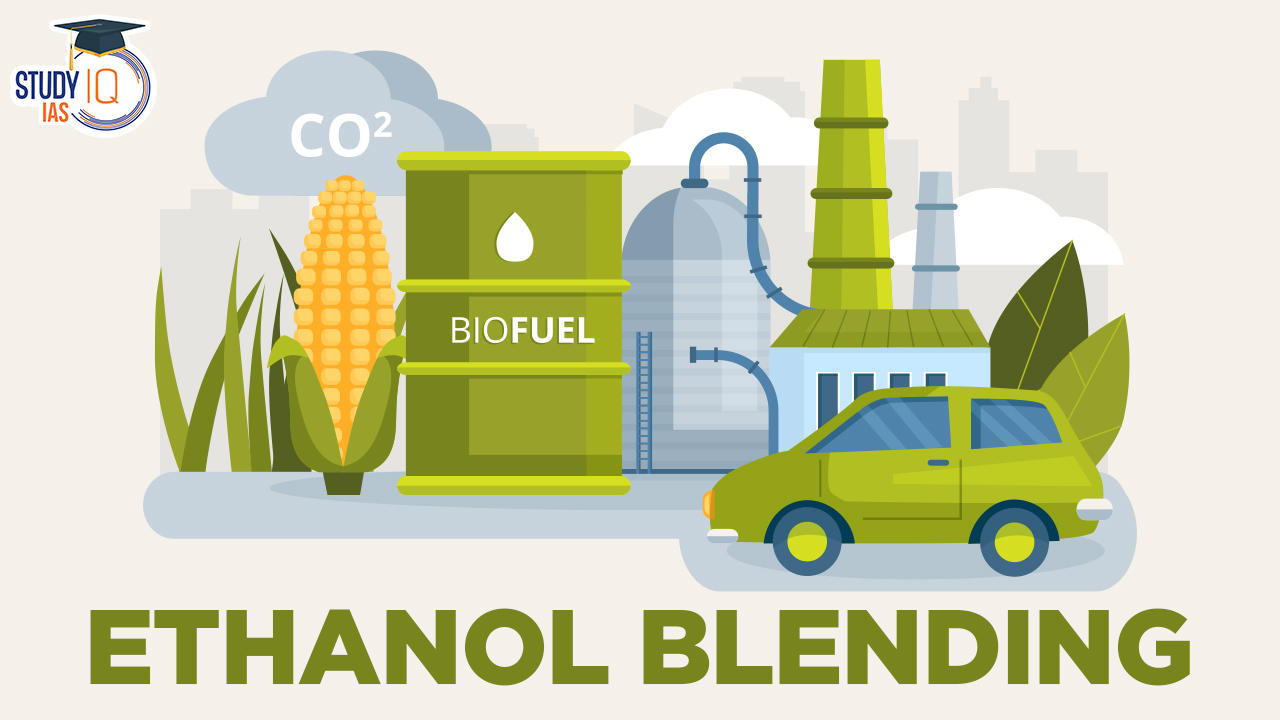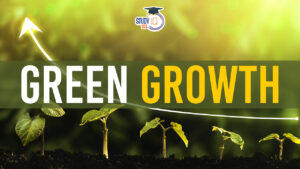Table of Contents
Context: Sugar mills in India are on course to meet 12% ethanol blending target for the current ethanol supply year (ESY).
More on the News
- Government has recently changed the ethanol year from November to October for the 2023-24 season, from December to November till now.
- The current transition year will run for 11 months, from December to October, and the 12% blending target has to be achieved by October 31.
- India aims to achieve a 20% ethanol blending target by 2025.
What is Ethanol Blending?
- Ethanol, an anhydrous ethyl alcohol having chemical formula of C2H5OH, can be produced from sugarcane, maize, wheat, etc which are having high starch content.
- In India, ethanol is mainly produced from sugarcane molasses by fermentation process.
- Ethanol can be mixed with gasoline to form different blends.
- As the ethanol molecule contains oxygen, it allows the engine to more completely combust the fuel, resulting in fewer emissions and thereby reducing the occurrence of environmental pollution.
- Since ethanol is produced from plants that harness the power of the sun, ethanol is also considered as renewable fuel.
What is the need for Ethanol Blending?
- Saving Exchequer: According to a report by a special expert committee set up by the Centre, India’s net import of petroleum was 185Mt at a cost of $551 billion in 2020-21.
- Hence, a successful E20 programme can save the country $4 billion per annum, that is, around Rs 30,000 crore.
- Climate Friendly: ethanol is a less polluting fuel and offers equivalent efficiency at lower cost than petrol.
- Hydrocarbon emissions are reduced by 20% with ethanol blends compared to normal gasoline.

- Fuel Efficiency: Enhancing engine performance: Ethanol serves as an octane booster, which can enhance engine efficiency and lessen knocking noises.
- Support for the agricultural sector: It will help the sugar mill owner to pay farmers their pending FRP for sugarcane.
- It will also mitigate the problem of low sugar prices in the international market.
- Farmers Income: More ethanol produced from farm residue will boost farmers’ income and minimise air pollution by reducing the amount of stubble burned.
What is its Performance so Far?
- Roadmap for Ethanol Blending in India 2020-25: It mentioned an intermediate milestone of 10% ethanol blending to be achieved by November 2022.
- However, due to the coordinated efforts of the Public Sector Oil Marketing Companies (OMCs) the target of 10% blending under the programme has been achieved much ahead of the targeted timelines of November 2022.
- This achievement in the course of last 8 years has not only augmented India’s energy security but also translated into a forex impact of over Rs.41,500 crores, reduced GHG emissions of 27 lakh MT and also led to the expeditious payment of over Rs.40,600 crores to farmers.
What are the Challenges in Ethanol Blending?
- Making efficient vehicles: There is an estimated loss of six-seven per cent fuel efficiency for four-wheelers and three-four per cent for two-wheelers when using E20. These vehicles are originally designed for E20 and calibrated for E10.
- Unregulated emissions: The unregulated carbonyl emissions, such as acetaldehyde emission were higher with E10 and E20 compared to normal petrol.
- Price uncertainty: The prices of both ethanol and sugarcane are fixed by the government leading to concerns among investors regarding the price of bioethanol.
- Expensive: These fuels although are cleaner and complete combustion take place in them but have higher evaporative emissions from fuel tanks and dispensing equipment.
- Food Insecurity: Sugar and cane production that end up in the petrol tank cannot also appear on the dinner plate, in animal fodder, be stored in warehouses, or be exported.
- No Reduction in Emission of Nitrous Oxide: Because ethanol burns more completely than petrol, it avoids emissions such as carbon monoxide. However, there is no reduction in nitrous oxides, one of the major environmental pollutants.
About Ethanol Blended Petrol (EBP) Programme
- Ethyl alcohol or Ethanol (C2H5OH) is a biofuel that is naturally made by fermenting sugar.
- While it is mostly derived by extracting sugar from sugarcane, other organic matter like foodgrains can also be used for its production.
- One tonne of sugarcane yields around 70-75 litres of ethanol if processed directly from juice, while one tonne of B-Heavy Molasses produces about 320 litres of biofuel.
- Ethanol Blended Petrol (EBP) programme: As part of its carbon reduction commitments, India has launched the Ethanol Blended Petrol (EBP) programme to mix this biofuel with petrol to reduce the consumption of fossil fuel.
- Launch: It was launched in January, 2003 in in 9 States and 4 UTs. Later, it has been extended to whole of India except Union Territories of Andaman Nicobar and Lakshadweep islands with effect from 01st April, 2019.
- Objective: It seeks to achieve blending of Ethanol with motor sprit with a view to reducing pollution, conserve foreign exchange and increase value addition in the sugar industry enabling them to clear cane price arrears of farmers.
- Targets: In December 2020, the government advanced its target of achieving 20% blending (E20) from 2030 to 2025.

- “Roadmap for Ethanol Blending in India: 2020-2025”
- Raise pan-India ethanol production capacity from the current 700 to 1500 crore litres.
- Phased rollout of E10 fuel by April 2022.
- Phased rollout of E20 from April 2023, its availability by April 2025.
- Rollout of E20 material-compliant and E10 engine-tuned vehicles from April 2023.
- Production of E20-tuned engine vehicles from April 2025.
- Encourage use of water-sparing crops, such as maize, to produce ethanol.
- Promote technology to produce ethanol from non-food feedstock.
Way Forward
- Ethanol would need to be distributed from surplus to deficit states according to criteria to enable a pan-Indian roll-out and to ensure uniform availability of ethanol blends throughout the nation.
- Promoting Advanced Biofuels: To take advantage of this readily available resource without compromising the food production system, “Advanced Biofuels” technology, including second generation (2G), should be encouraged.
- Establishing a Floor Price for Ethanol: The government may set a floor price for ethanol for a few years with an escalation clause for purchase by oil marketing corporations to offer consistency and to promote investment by entrepreneurs in expansion/new ethanol capabilities.
- Food security and ethanol blending must coexist in harmony, according to India’s biofuel strategy, which also prohibits using any food crops that are overabundant for fuel production.
- Future-proofing the automotive industry: The industry and petrol stations should be prepared for future initiatives like E85 and E100.


 India China Trade Deficit, India’s imp...
India China Trade Deficit, India’s imp...
 Current Affairs 29th April 2024 for UPSC...
Current Affairs 29th April 2024 for UPSC...
 Towards Green Growth, Impact of Climate ...
Towards Green Growth, Impact of Climate ...

















